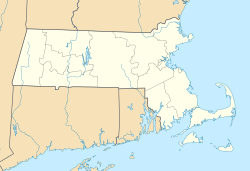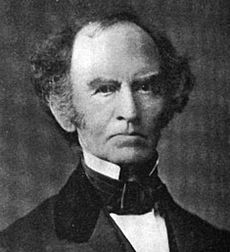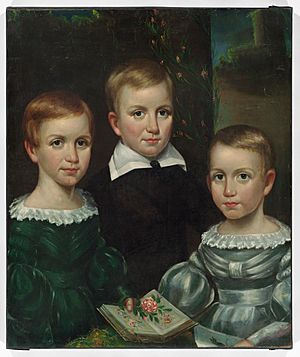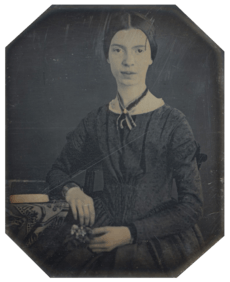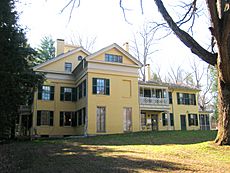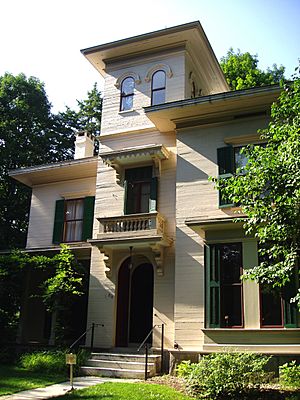Emily Dickinson Museum facts for kids
|
Emily Dickinson Home
|
|
|
U.S. Historic district
Contributing property |
|
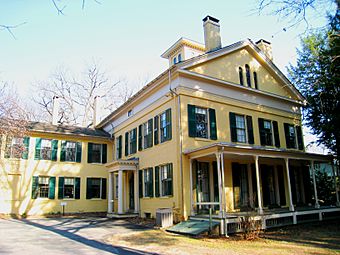
The Dickinson Homestead was the home of famous poet Emily Dickinson.
|
|
| Location | 280 Main St., Amherst, Massachusetts |
|---|---|
| Area | 3 acres (1.2 ha) |
| Built | 1813 |
| Architectural style | Federal |
| Part of | Dickinson Historic District (ID77000182) |
| NRHP reference No. | 66000363 |
Quick facts for kids Significant dates |
|
| Added to NRHP | October 15, 1966 |
| Designated NHL | December 29, 1962 |
| Designated CP | August 16, 1977 |
The Emily Dickinson Museum is a special place where you can step back in time. It is made of two historic houses in Amherst, Massachusetts. The main house is the Dickinson Homestead, where the famous American poet Emily Dickinson was born and lived. The other house is The Evergreens, which was built for her brother.
Emily Dickinson lived in the Homestead for most of her life, from 1855 until she died in 1886. After she passed away, her family found hundreds of her poems hidden in her bedroom. The two houses are now a single museum. You can visit them to see what her life was like. The museum is also a U.S. National Historic Landmark, which means it is a very important place in American history.
Contents
A Home for a Poet
The Dickinson family was one of the first English families to settle in the area. In 1813, Emily's grandfather, Samuel Fowler Dickinson, built the large brick house that would become known as the Homestead. He was a successful lawyer, and the house showed his importance in the town.
However, he had money problems and had to sell the house.
The Dickinson Family Moves In
In 1830, Emily's father, Edward Dickinson, bought back part of the Homestead. He moved in with his wife and their son, Austin. Nine months later, on December 10, 1830, their daughter Emily was born in the house. Her younger sister, Lavinia, was born there three years later.
Money was still tight, and the family had to sell the house again in 1833. They moved to a nearby home for fifteen years. During that time, Edward became a wealthy and important man. In 1855, he was able to buy the entire Homestead and the land around it. The family moved back in.
The next year, Edward built a beautiful house next door called The Evergreens. It was a wedding gift for his son Austin and his new wife, Susan.
The property had a large garden that Emily, her sister, and her mother loved to care for. Emily often sent flowers from the garden to her friends along with her poems. A path connected the two houses, which Emily called "just wide enough for two who love."
Emily's Life at the Homestead
Emily Dickinson spent most of her life at the Homestead. She loved her home and her garden. Starting in the 1850s, she began to live a very private life. She preferred to stay at home and rarely had visitors.
She would often talk to guests through a closed door instead of meeting them face-to-face. She once wrote to a friend that she did not "cross my Father's ground to any House or town."
Even though she was private, she was not lonely. She wrote hundreds of poems and letters to friends and family. She also enjoyed spending time in her garden and visiting her brother's family next door at The Evergreens.
Emily died in 1886. After her death, her sister Lavinia found a locked chest in Emily's room. Inside were nearly 1,800 poems. Lavinia knew how important they were and worked to get them published. The first complete collection of Emily's poetry was published in 1955.
What Happened to the Houses?
After Emily and her parents passed away, her sister Lavinia lived in the Homestead until her death in 1899. The house was then passed down through the family. In 1965, Amherst College bought the house and began offering tours of Emily's room to the public.
Next door, The Evergreens was kept exactly as it was when Austin and Susan lived there. It was like a time capsule from the 1800s. In 2003, the two houses were joined together to create the Emily Dickinson Museum.
The Museum Today
Today, the Emily Dickinson Museum is open for visitors who want to learn about the poet's life. You can take a guided tour to see the rooms where she lived and wrote.
The Homestead
The Homestead is a large brick house. When Emily lived there, her father added a veranda, a special room for her plants called a conservatory, and a decorative cupola (a small dome) on the roof.
In 2004, the house was repainted to look just as it did when Emily knew it. This helps visitors imagine what her world was like.
The Evergreens
The Evergreens is a beautiful example of a style of house called Italianate. It is still filled with the original furniture and decorations from the Dickinson family.
Austin Dickinson was very interested in landscaping. He designed the gardens around The Evergreens to look natural and beautiful. He planted many different kinds of trees and shrubs. The family even played games like lawn tennis and badminton on the lawn between the two houses.
Visiting the Museum
The Emily Dickinson Museum offers guided tours from March through December. While you can walk around the gardens for free, you need to be on a tour to go inside the houses. The museum also hosts poetry readings and other special events. It is owned by Amherst College and is a popular destination for anyone who loves poetry and history.
See also


